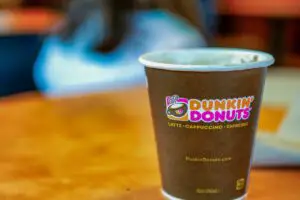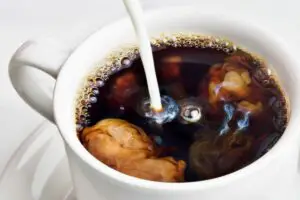*This post may contain affiliate links. As an Amazon Associate we earn from qualifying purchases.
Ah, Starbucks. The holy mecca of overpriced coffee and my personal sanctuary from a house full of children’s toys, homework, and the inevitable argument about who’s the favorite child. (For the record, it’s whoever’s not currently screaming).
Starbucks has a special place in my heart – and in the hearts of millions across the globe. It’s the same cozy atmosphere, the same snappy baristas, and most importantly, the same taste, no matter where you are.
But, have you ever stopped to wonder, how do they manage that consistent taste?
I mean, how can a Pumpkin Spice Latte taste identical in Seattle, Singapore, or Soweto? I’m not just talking about the coffee itself, but even the water in the coffee tastes the same.
Seriously, if Starbucks sold its water, I’d buy it.
Ready to embark on a wild ride to the heart of the Starbucks empire? No need to fasten your seatbelts – the only turbulence here is from the caffeine jitters.
We’re about to dive deep into the world of Starbucks, water, and why the two together are the very essence of my sanity.
Key Takeaways
- Water quality is crucial for achieving consistent taste in Starbucks’ beverages. Water hardness, pH balance, and mineral content all play a significant role in how coffee and tea taste.
- Starbucks employs advanced water filtration systems to ensure the removal of impurities while retaining essential minerals. Reverse Osmosis, Activated Carbon filters, and Ion Exchange filters are used to achieve optimal water quality.
- The company maintains strict water quality standards across all its locations, ensuring a consistent taste experience for customers worldwide. The Starbucks Quality Assurance team monitors and upholds these standards.
- The brewing process for Starbucks’ espresso-based drinks requires precise control of water temperature, pressure, and extraction time. Tea beverages are brewed at specific temperatures based on the tea type.
- Starbucks adapts its water filtration systems to different geographic locations to accommodate varying water characteristics, such as hardness and mineral content. They strive to maintain taste consistency while embracing local flavors.
- Water quality greatly influences customer perception and contributes to building brand loyalty. Starbucks customers appreciate the ability to rely on a consistent taste experience no matter where they are.
- Starbucks is committed to environmental sustainability and employs initiatives to reduce water waste and increase efficiency. They promote responsible farming practices and engage in community projects to improve access to clean water.
- Water is an essential resource that connects us all, and Starbucks’ dedication to water quality and sustainability contributes to a greater movement of positive change.
So, the next time you enjoy your favorite Starbucks beverage, remember the importance of water in creating that consistent, delightful taste experience. It’s the secret ingredient that brings joy to coffee lovers and keeps us coming back for more.
Cheers to the power of water and the love affair we have with our beloved Starbucks!
The Watered Down Truth About Starbucks’ Secret Ingredient
Ever thought about the fact that a cup of coffee is 98% water? I mean, with the prices Starbucks charges, you’d think they were pouring liquid gold, but nope, it’s mostly water.
And I’m not just talking about any ol’ water, we’re talking about H2O that’s been treated like it’s about to meet the Queen. Water that’s been pampered more than I have been since I had kids.
What’s Water Got to Do with It?
Why does water matter, you ask? Well, remember that time your 8-year-old tried to make coffee with orange juice because, and I quote, “It’s also a liquid, mom!” (true story, don’t recommend it)?
Just as orange juice and coffee are a disaster together, the wrong kind of water can really mess with your coffee. It can make it taste bitter, flat, or even metallic.
That’s why water isn’t just water when it comes to brewing your favorite pick-me-up. It’s the secret star of the show, the unsung hero in your cup.
Water hardness, pH balance, and mineral content all play a crucial role in how your coffee tastes. For example, hard water, which is high in minerals, can make your coffee taste more bitter.
On the other hand, soft water can make it taste flat. As for pH balance, acidic water can enhance the acidity in your coffee, while alkaline water can do the opposite.
So, you see, water isn’t just there to make your coffee wet. It’s there to dance with the coffee, to blend and twirl in perfect harmony to create that magical elixir that keeps moms like me from turning into zombies.
Starbucks’ Water: The Rolls-Royce of H2O
So how does Starbucks ensure that the water used in all of its 30,000 locations worldwide is up to snuff? They don’t just turn on the tap and hope for the best, no sir.
Starbucks has advanced water filtration systems that make sure every single cup of coffee tastes almost identical no matter which Starbucks location you visit! These systems are designed to remove any impurities from the water, without stripping it of the essential minerals that give Starbucks coffee its unique taste.
Imagine if you could do that with your kids – remove the impurities (like the constant arguing and the inability to pick up after themselves) while
Brewing the Perfect Cuppa: The Role of Water Filtration Systems
Now, let’s take a closer look at the types of water filtration systems that Starbucks employs to ensure every sip is a little slice of heaven. These systems work tirelessly to filter out the bad stuff while keeping the good stuff intact.
One of the main filtration methods Starbucks uses is Reverse Osmosis. It’s like the superhero of water filtration.
Reverse osmosis systems use a semipermeable membrane to remove impurities, such as minerals and contaminants, leaving behind clean, purified water. This process ensures that each cup of coffee or tea is free from any unwanted elements that could taint the taste.
Another filtration method in Starbucks’ arsenal is Activated Carbon filters. These filters use a process called adsorption (not to be confused with absorption) to trap impurities and chemicals, ensuring that only the purest water flows through to the brewing process.
It’s like having a tiny army of carbon warriors battling the evil taste-stealing villains in your water.
But wait, there’s more! Starbucks also employs Ion Exchange filters to maintain the right balance of minerals in the water. These filters work by swapping out undesirable ions for more desirable ones.
It’s like a water chemistry class where only the cool kids get to join the party. By controlling the mineral content, Starbucks can achieve the consistent taste we all know and love.
Sipping Standards: The Secret Recipe for Consistent Taste
Starbucks doesn’t just rely on fancy filtration systems alone; they have a set of water quality standards that would make even the strictest teacher nod in approval. These standards ensure that every cup you drink is as consistent as your daily morning routine (hello, frizzy bedhead and mismatched socks).
The Starbucks Quality Assurance team is the guardian of these standards. They ensure that water hardness, pH balance, and mineral content meet the exact specifications to deliver that signature taste.
But why does consistency matter so much to Starbucks? Well, imagine walking into your favorite Starbucks in downtown Seattle, ordering your usual Caramel Macchiato, and taking that first glorious sip, only to find it tastes more like burnt rubber and despair.
Yeah, not exactly the coffee experience you were hoping for. Starbucks knows that maintaining a consistent taste is crucial for customer satisfaction and brand loyalty. It’s the secret sauce that keeps us coming back for more (and keeps me from losing my mind in the process).
Brewing Magic: The Art of Coffee and Tea Extraction
Okay, let’s get down to the nitty-gritty of how Starbucks uses water to brew their delicious concoctions. We’re talking espresso, tea, and everything in between. It’s like a caffeine symphony in motion.
For their espresso-based drinks, Starbucks utilizes a finely tuned process that involves precise water temperature, pressure, and extraction time. The water temperature must be just right to extract the flavors from the coffee grounds without scorching them.
Too hot, and you’ll end up with a bitter cup; too cold, and it’ll taste like…well, disappointment.
The brewing process for Starbucks’ tea beverages is a whole different ballgame. Here, the water temperature is adjusted based on the type of tea being brewed.
Black teas, for example, require hotter water to release their bold flavors, while delicate green teas prefer a gentler touch. It’s all about finding the sweet spot for each tea variety to ensure that every sip is a tea lover’s dream come true.
And let’s not forget about the water-to-coffee ratio.
Ah, the sacred water-to-coffee ratio. It’s the holy grail of brewing perfection. Starbucks understands that getting this ratio right is crucial to achieving that consistent taste we all crave.
Too much water, and your coffee might taste weak and watery, like the tears of a disappointed barista. Too little water, and you’ll end up with a concentrated, overpowering brew that could jump-start a rocket.
To ensure precision in their brewing process, Starbucks baristas follow strict guidelines and use precise coffee-to-water measurements. It’s a delicate dance of grams and milliliters, where every ounce counts.
Whether it’s an espresso shot or a full-bodied pour-over, Starbucks leaves no room for error. They know that even the smallest deviation can alter the flavor profile and leave you with a less-than-perfect cup of joe.
But hey, don’t just take my word for it. Starbucks’ commitment to excellence is backed by rigorous training programs for their baristas. These coffee connoisseurs learn the art of brewing, including the intricate dance between coffee and water, to ensure that every customer receives a top-notch beverage.
Water, my friends, is the unsung hero that can turn a disaster into a semi-tolerable situation. It’s what gives coffee its life, its flavor, and its ability to keep me somewhat sane in the midst of the chaos.
Sailing the Seas of Water Quality: Starbucks’ Global Approach
Starbucks has conquered the globe with its caffeinated empire, and each location poses unique challenges when it comes to water quality. You see, water isn’t the same in every corner of the world. It can be hard, soft, mineral-rich, or even a little funky (looking at you, sulfuric water).
Adapting to Local Waters: Starbucks’ Filtration Solutions
When Starbucks sets sail to a new destination, they take into account the characteristics of the local water. They adjust their water filtration systems to ensure that the water used in each location meets their high-quality standards.
It’s like they have a magical wand that can transform even the murkiest of waters into liquid gold.
Take, for example, their approach in areas with hard water. Starbucks employs robust filtration systems that remove excess minerals and prevent scale buildup in their espresso machines.
They don’t want their baristas to spend more time descaling than actually brewing coffee, after all.
On the flip side, in areas with softer water, Starbucks may make slight adjustments to ensure that the flavors aren’t muted. They want their coffee to shine like a diva on stage, not get lost in the sea of subtlety.
Starbucks knows that water is a key ingredient that can make or break the taste of their beverages, and they’re determined to make every sip a delightful experience no matter where you are in the world. They conduct extensive water quality testing to understand the specific characteristics of each location’s water and tailor their filtration systems accordingly.
Water is not only a factor controlled by Starbucks, but it’s also influenced by the local environment. Starbucks strives to strike a balance between their global standards and the unique characteristics of each location. It’s a delicate dance between consistency and adaptation, ensuring that their beverages maintain their familiar taste while embracing the local flavor.
Savoring the Perceptions: Water Quality and Customer Satisfaction
You may wonder, does the average Starbucks customer even notice the intricate dance between water and coffee? Well, my caffeinated friend, let me tell you that water quality can make a significant impact on customer perception.
The Quest for Consistency: Building Brand Loyalty
Starbucks has built its empire on delivering a consistent experience. From the familiar green logo to the cozy ambiance, customers know what to expect when they walk through those doors.
And water quality is no exception. The commitment to maintaining a consistent taste across all locations helps build brand loyalty and keeps customers coming back for more.
Imagine being a devoted Starbucks enthusiast and ordering your favorite drink from a new location. You take that first sip, and a wave of relief washes over you as the familiar flavors dance on your taste buds.
It’s a moment of reassurance that Starbucks is consistent, reliable, and deserving of your loyalty (and your hard-earned money).
When Taste Tells the Tale: Customer Testimonials
If you need more convincing about the impact of water quality on customer satisfaction, just dive into the world of customer testimonials. Take a moment to peruse the vast sea of online reviews, and you’ll find passionate discussions about the taste consistency of Starbucks’ beverages.
Customers often express their appreciation for the fact that no matter where they are in the world, they can rely on Starbucks to deliver the same flavors they’ve come to love. It’s like having a trusted friend who never disappoints, always there to provide a comforting cup of perfection when you need it most.
The true power of Starbucks’ commitment to water quality and taste consistency. It’s not just about the coffee; it’s about the emotional connection it creates. When you can rely on the same taste, no matter the location, it becomes a comforting ritual—a moment of familiarity and indulgence amidst the unpredictable chaos of life.
A Brew for Good: Starbucks’ Environmental Sustainability Efforts
While we’ve delved deep into the world of water and taste, we can’t overlook the environmental impact of Starbucks’ water usage. As a responsible global corporation, Starbucks is dedicated to reducing water waste and increasing efficiency.
Brewing with a Conscience: Environmental Responsibility
Starbucks recognizes that water is a precious resource, and they strive to use it responsibly. They have implemented various initiatives to minimize their environmental footprint and contribute to sustainable water practices.
One of their key focuses is water conservation. Starbucks has set ambitious goals to reduce water usage in their stores and operations. Through technological advancements, such as water-efficient equipment and optimized processes, they aim to minimize water waste without compromising the quality of their beverages.
Additionally, Starbucks prioritizes wastewater management. They work closely with local municipalities and experts to ensure that their wastewater is treated effectively and safely returned to the environment.
By adhering to strict water quality standards, they play their part in preserving the delicate balance of ecosystems.
From Bean to Cup: A Journey of Responsibility
Starbucks takes a holistic approach to sustainability, recognizing that water is just one piece of the puzzle. They have implemented comprehensive programs throughout their supply chain to promote responsible farming practices and water stewardship.
Through collaborations with farmers and organizations, Starbucks supports initiatives that focus on sustainable water management in coffee-growing regions. They provide resources, education, and training to help farmers optimize their water usage, protect water sources, and foster a healthier environment for both people and nature.
In line with their commitment to corporate social responsibility, Starbucks actively engages in community projects to improve access to clean water in underserved areas. They partner with organizations like the Starbucks Foundation to invest in water infrastructure projects, enabling communities to thrive by having access to this vital resource.
It’s heartwarming to know that while we sip our favorite Starbucks beverages, we are contributing to a larger movement of sustainability and positive change.
Conclusion: The Water Source That Connects Us All
As I wrap up this caffeine-fueled journey into the world of Starbucks’ water source and taste consistency, one thing is clear: water is more than just a means to an end. It’s the unsung hero that transforms ordinary beans into extraordinary brews.
It’s the secret ingredient that ties together Starbucks’ global empire, ensuring that whether you’re in Tokyo, Paris, or my humble abode, you can always rely on the same taste that has captured the hearts of millions.
Starbucks’ commitment to water quality, filtration systems, and global standards ensures that every sip is a moment of bliss, a reminder that life’s chaos can be tamed, if only for a moment, with the perfect cup of coffee or tea.
So, the next time you take that first sip of your beloved Starbucks beverage, pause for a moment to appreciate the journey that water has taken to reach your cup. From the advanced filtration systems to the careful calibration of flavors, it’s a testament to Starbucks’ unwavering dedication to delivering a consistent, high-quality experience.
Now, if you’ll excuse me, I have a date with my favorite Starbucks location. It’s the place where the baristas know my name, where the aroma feels like a warm embrace, and where I can get away from my three kids for a few minutes (you don’t mind watching the kids right Dear?).









